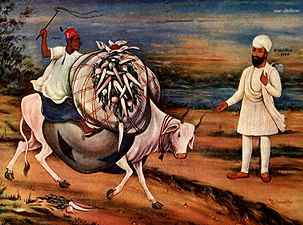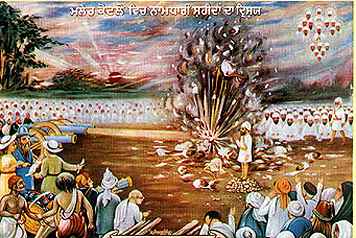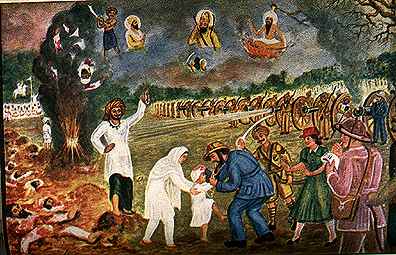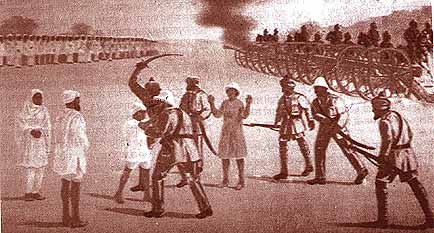|
|
|
|
|
|
|
|
|
|
|
|
|
|
|
[Page
1] [Page 4] |
|
|
|
|
|
|
|
|
|
|
|
|
|
|
|
|
|
|
|
|
|
|
|
|
|
Back |
|
|
|
|
|
|
|
|
|
|
|
|
|
|
|
|
|
|
|
|
|
Namdhari Shaheeds
-
Foremost Freedom Fighters-Page 3 |
|
|
|
|
|
|
|
|
|
|
|
|
|
|
|
|
|
|
|
 |
|
|
|
|
|
|
|
|
|
|
|
|
|
|
|
|
|
|
|
|
|
S.
Gurmukh Singh asking the Muslim trader to not to mistreat the highly laden ox.
A dispute occured and the magistrate ordered the ox to be slaughtered in front
of Gurmukh Singh. |
|
|
|
|
|
|
|
|
|
The
open permission for kine killing in the Punjab accorded to Muslims by the British
rulers was assented bitterly by all sections of the non-Muslim population. Muslims,
on the other hand became over-zealous everywhere and deliberately injured the
religious sentiments of their Hindu and Sikh neighbours. An incident of a minor
nature, in which a Namdhari had requested a vegetable seller to come down from
the back of an ox, resulted in altercations between Gurmukh Singh Namdhari and
a Muslim at Malerkotla. The matter went to the court and the Muslim judge instead
of pacifying the excited feelings ordered that the ox be butchered before the
eyes of Gurmukh Singh. Orders were instantly carried out. Next day Gurmukh Singh
went to Bhaini Sahib to attend a gathering, and narrated what had taken place
before his eyes. |
|
|
|
|
|
|
|
On
13th January 1871, a batch of about 2O0 Namdharies under the leadership of Sardars
Hira Singh and Lehna Singh started for Kotla to avenge the wrong done to one
of their fellow religionists by the fanatic Muslim judge. On the way, there
was a free fight with the men of the Sikh Feudal Chief of Malaudh in which.
2 Namdharies and two men of the Sardar group were killed. On the morning of
15th there was a riot between the Namdharies and the officials of the Malerkotla
State. Eight Kotla men were killed and several wounded. On the side of the Namdharies,
7 died on the spot, and 2 wounded were captured, besides, 29 severely wounded
who had left the city. One of the two wounded died later on |
|
|
|
|
|
|
|
|
|
|
|
|
|
|
|
|
|
 |
|
|
|
|
|
|
|
|
|
|
|
|
|
|
|
|
|
|
|
A
Kuka Waryam Singh was rather short in height, and was related to the Maharaja
of Patiala. A member of the firing squad was interested in saving his life.
So he alleged that this man could not be blown, as his height was lower than
the cannon aim. Waryam Singh ran at once to the neighbouring ploughed field
and brought some stones with him. He stood on these stones and challenged the
gunman to fire as his height now posed no problem to the cannon aim. |
|
|
|
|
|
|
|
|
The Namdharies left the city and reaching the police post Sherpur in the
Patiala State voluntarily surrendered themselves to the police officials.
In the meantime, Mr. Cowan, the Deputy Commissioner of Ludhiana district,
had reached Malerkotla. The ruler of the state was a minor and Mr. Cowan was
working as superintendent of the Council of administration. He ordered that
the Namdharies should be brought before him. On the 17th January, 49 of them
were blown away with guns and the fiftieth cut to pieces with swords without
trial. On the 18th, the remaining sixteen were also done to death in the same
ghastly manner by an order of Mr. Forsythe the Commis-sioner of Ambala Division.
"Kuka-Massacre al Maler-Kotla." "These reminiscences of 1872 would be incomplete
without some reference to what I can only describe as the Massacre at Maler
Kotla. .. For my part, I can recall nothing during my service in India, more
revolt-ing and shocking than these executions, and there were many who thought,
as I did, still think, that the final orders of the Government of India were
lamentably inadequate. (Indian and Home memories by Sir Henery Cotton.P.110-113)
|
|
|
|
|
|
|
|
|
|
|
|
 |
|
|
|
|
|
|
|
|
|
|
|
|
|
|
|
|
|
|
The
last person to be executed was a boy of thirteen years by the name of Bishan
Singh. Mr. Cowan's wife felt pity for the boy and asked her husband to release
him. Cowan went to the boy, bent down to him and said: "Disown the fool Ram
Singh and you will be pardoned." The boy got enraged on hearing his Guru being
abused. He jumped up, caught hold of the beard of Cowan and did not let it go
till both his hands were severed. His body was cut to pieces and he became a
martyr. |
|
|
|
|
|
|
|
|
|
|
|
 |
|
|
|
|
|
|
|
|
|
|
|
|
|
|
|
|
|
|
|
Shaheed
Bishan Singh being hacked with a sword for wrenching the beard of Cowan. |
|
|
|
|
|
|
|
|
|
|
|
|
|
The
Government took the occasion as affording an appropriate opportunity for exercising
its absolute power for crushing the Namdhari movement. Guru Ram Singh and his
three Subahs, Jawahar Singh, Sahib Singh, and Lakha Singh and his personal attendant.
Nanoo Singh were put under arrest on the night of 17th and taken to Allahabad.
Immediately after, Sahib Singh, Rur Singh Kahn Singh, Barhma Singh, Maluk Singh,
Man Singh and Hukma Siugh were also arrested and sent to Allahabad All of them
were ordered to be kept in detention under Bengal Regulation III of 1818. Consequently,
Guru Ran Singh Ji was taken to Rangoon in March 1872, along with his personal
attendant, Nanoo Singh, and the Subahs were confined in different jails. |
|
|
|
|
|
|
|
|
|
|
|
|
|
|
|
|
|
|
|
|
|
Back]
Next |
 |
 |
 |
 |
 |
 |
 |
 |
 |
 |
 |
 |
 |
 |
 |
 |
 |
 |
 |
 |
 |
 |
 |
 |
 |
 |
 |
 |
 |
 |



